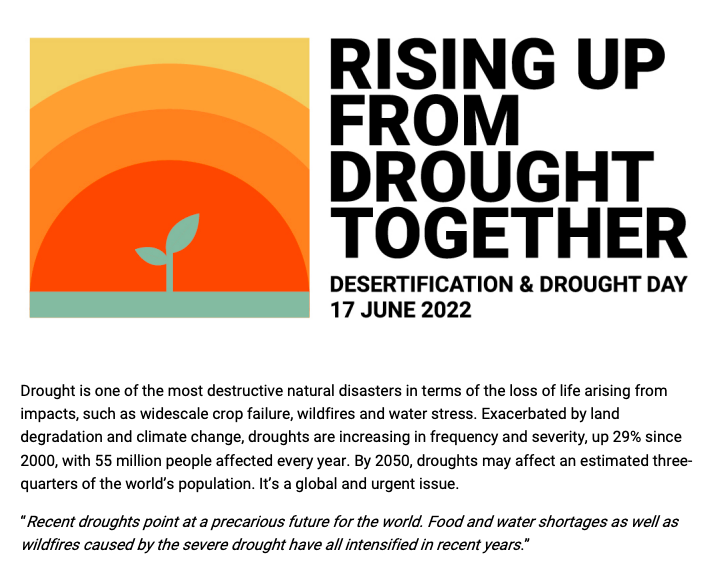World Day to Combat Desertification and Drought, 17 June
Rising up from drought together
Droughts are among the greatest threats to sustainable development, especially in developing countries, but increasingly so in developed nations too. In fact, forecasts estimate that by 2050 droughts may affect over three-quarters of the world’s population.
The number and duration of droughts has increased by 29 percent since 2000, as compared to the two previous decades (WMO 2021). When more than 2.3 billion people already face water stress, this is a huge problem. More and more of us will be living in areas with extreme water shortages, including an estimated one in four children by 2040 (UNICEF). No country is immune to drought (UN-Water 2021).
This year, the theme of the International Day Against Desertification, and Drought “Rising up from drought together”, emphasises the need of an early action to avoid disastrous consequences for humanity and the planetary ecosystems.

When the soil asks for help
Desertification is the degradation of land in arid, semi-arid and dry sub-humid areas. It is caused primarily by human activities and climatic variations. Desertification does not refer to the expansion of existing deserts. It occurs because dryland ecosystems, which cover over one third of the world’s land area, are extremely vulnerable to overexploitation and inappropriate land use. Poverty, political instability, deforestation, overgrazing and bad irrigation practices can all undermine the productivity of the land.
The World Day to Combat Desertification and Drought is observed every year to promote public awareness of international efforts to combat desertification. The day is a unique moment to remind everyone that land degradation neutrality is achievable through problem-solving, strong community involvement and co-operation at all levels.
The matter requires even more attention now. When the land degrades and stops being productive, natural spaces deteriorate and transform. Thus, greenhouse gas emissions increase and biodiversity decreases. It also means there are fewer wild spaces to buffer zoonoses, such as COVID-19, and protect us from extreme weather events, such as droughts, floods, and sand and dust storms.
The UNCCD is therefore calling on all members of the global community to treat the land as a limited and precious natural capital, prioritize its health in the pandemic recovery and push hard to restore the land during the UN Decade on Ecosystem Restoration. Everyone has a role to play because everyone has a stake in the future.
Did you know?
- Since 2000, the number and duration of droughts has risen 29%
- An estimated 55 million people globally are directly affected by droughts every year
- By 2050, droughts may affect over three-quarters of the world’s population
- More and more of us will be living in areas with extreme water shortages, including an estimated one in four children by 2040 (UNICEF)
- Between 1900 and 2019, droughts impacted 2.7 billion people in the world, and caused 11.7 million deaths



